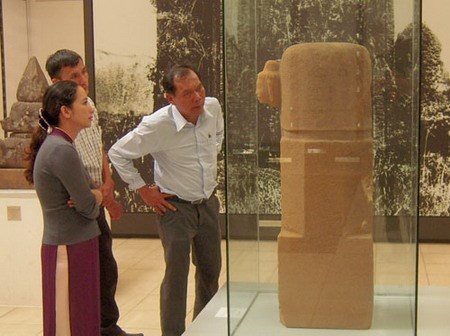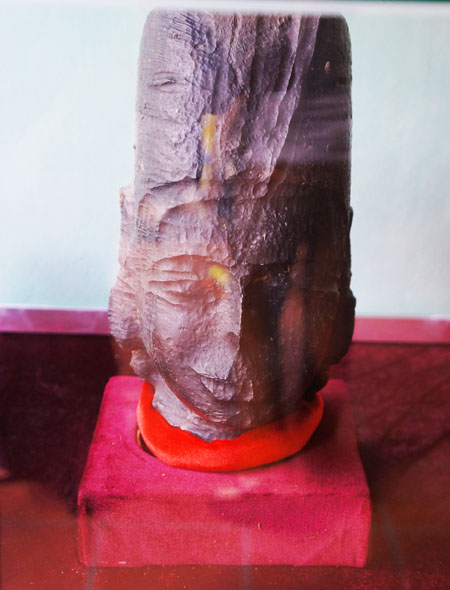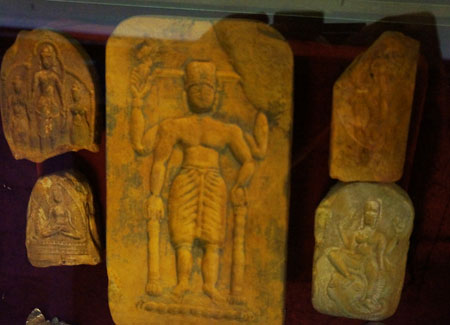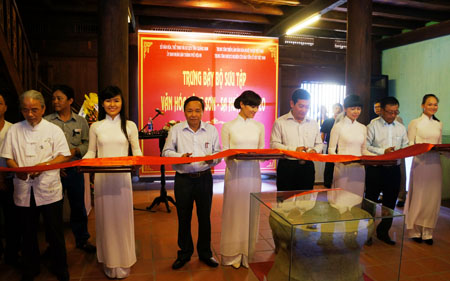last updated 9th November 2014
Vedic Culture in Vietnam
http://www.veda.harekrsna.cz/connections/Vedic-culture-in-Vietnam.php
Rare "mukhalinga' on display in Vietnam
http://www.thanhniennews.com/entertainment/rare-mukhalinga-on-display-in-vietnam-20587.html

A Hindu phallic symbol with Shiva's face carved into it was placed on display at the My Son Champa ruins in central Vietnam Saturday, becoming the first intact mukhalinga to be exhibited in Southeast Asia.
The statue is estimated to date back to the 7th or 8th centuries.
It was uncovered in November of last year as rains eroded the ground, around ten meters from one temple of My Son, which is a complex of Cham temple ruins in Quang Nam Province, not far from Hoi An.
Linga represents male creative energy according in Hinduism. Mukhalingas, lingams with the faces of humans and gods, began appearing in northern India during the 1st to 3rd centuries.
The item on display made from a block of brownish gold sandstone stands 1.46 meters high, with the Shiva bust on the round head.
Doctor Ngo Van Doanh from the Institute of Southeast Asian Studies at Vietnamese Academy of Social Sciences called the mukhalinga special, and the first intact one of its kind to be discovered in Southeast Asia.
It will be available for public viewing through month's end to mark the 14-year anniversary of the complex receiving UNESCO world heritage status.
Nguyen Cong Huong, chief manager of My Son, said mukhalingas were only known in Vietnam through images and documents.
"The display has been a big surprise to visitors,"? Huong said.
World's Most Ancient Vishnu Deity Discovered in Vietnam?
http://vedicempire.com/index.php?option=com_content&task=view&id=141&Itemid=26

A recent news report from Vietnam features an exquisite and very ancient sculpture of Lord Vishnu. According to a press release from the Communist Party of Vietnam’s Central Committee (CPVCC) the Vishnu sculpture is described as “Vishnu stone head from Oc Eo culture, dated back 4,000-3,500 years.” Recently the Government of Vietnam, despite its official Communist doctrine, has developed many programs and projects highlighting Vietnam’s ancient religious heritage. Its scholarly and archeological research and investigations are legitimate and its conclusions are authoritative. This discovery of a 4-3500 year old Vishnu sculpture is truly historic and it sheds new light upon our understanding of the history of not only Hinduism but of the entire world.

Vishnu and Various other Divinities in Copper from the Oc Eo Culture
The fact is there are no other ‘officially’ recognized Vedic artifacts that have been dated back to such an early date. This would make Vietnam home to the world’s most ancient Vedic artifact. While there are indeed many other ancient artifacts that represent the same Deity, they are not presented in the ‘Indic’ tradition and cannot be directly recognized as the Vishnu of the Indic Vaishnava tradition.
The 4000-3500 year old Vietnamese Vishnu sculpture is part of an exhibit featuring some of Vietnam’s most ancient artifacts. It was discovered in the region of Southern Vietnam's Mekong Delta. The Mekong (Ma Ganga) River is named after the Ganges River of India. The entire region was once the home to several ancient and prosperous Vedic Kingdoms and many intriguing and unique Vedic artifacts have been discovered.
The Vishnu sculpture was officially presented during the 5th Quang Nam Heritage Festival which opened on June 21, 2013 in Hoi An City. The exhibition highlights many ancient objects dated from the Dong Son – Sa Huynh – Oc Eo eras of Vietnam’s ancient history.
“Entitled “Dong Son – Sa Huynh – Oc Eo cultures”, the exhibition put on display over 1,000 ancient objects which come from across the country and are made from diverse materials, from pottery to copper, including jewelry and farming tools, from the pre-ancient period belonging to the three cultures.

Dong Son, Sa Huynh and Oc Eo. Deputy Minister of Culture, Sports and Tourism Huynh Vinh Ai and representatives from Quang Nam provincial People’s Committee and
related agencies cut the ribbon to open the exhibition.”
The significance of this discovery cannot be overestimated. The entire history of Hinduism and Vedic culture, as taught is the academic institutions of the world, has been built upon a false construct. According to mainstream academia Vedic ‘religion’ or Hinduism did not exist until the alleged ‘Aryans’ invaded India circa 1500 BC. An even later date is given to Vaishnavism which is speculated to have been derived from animist Sun worship. Yet here we have a highly evolved art form depicting Lord Vishnu in the Far South East region of Asia dated to somewhere between 2000 BC to 1500 BC.
This completely undermines the entire historic timeline developed by mainstream academia in regards to the development of both Vedic/Hindu civilization and Indian history.
The region of modern India has always been the epicenter of High Vedic/Hindu Civilization and culture. No one anywhere has ever suggested the region of modern Vietnam to be the origin of Hindu civilization yet it is in Vietnam that we now have the world’s most ancient example of Indic style Vedic Vaishnava art. Thus it stands to reason that if Vedic Vaishnava art, culture and religion flourished 4000 years ago in prehistoric Vietnam it was undoubtedly flourishing in ancient India as well.
Once again science and archeology have confirmed the Vedic conclusion. As the Vedic literature states 5000 years ago India was home to a highly evolved and advanced civilization. This civilization was centered on its sacred traditions. The worship of the Supreme Lord Vishnu, Lord Shiva, Lakshmi and Durga was widespread and in fact spanned the entire globe.
These traditions presented themselves in diverse manners, as seen in modern India, yet among this diversity was a commonality based upon the authority of the Vedic scriptures and traditions. The recognizably Indic forms of the Vedic traditions spanned the globe from the Philippines to the Middle East and Siberia to Australia. Yet the same Divinities were worshiped and the same traditions were practiced throughout the world.
The many recent Vedic discoveries from Vietnam are providing a new and sensational view into the authentic history of the world. Not only this, it presents a challenge to Modern India and its leadership. India is home to many startling and amazing artifacts yet they sit ignored and crumbling. In many cases looters and vandals have destroyed many priceless examples of India’s ancient heritage. India’s leading academics and governing bodies are silent and if they do speak of India’s ancient Hindu heritage it is only to cast doubts and disparage India’s indigenous Vedic culture and Hindu traditions.
Astounding and marvelous ruins and artifacts that would be the pride of any other nation and people are, in general, ignored and forgotten and left to crumble into oblivion. Often they are threatened by the efforts of the various Governmental bodies in the name of progress such as the National Highways Authority of India’s (NHAI) recent attempts to destroy a 1000 year old Shiva temple in Tamil Nadu.
It is a great irony that the officially atheistic Communist Government of Vietnam exhibits more pride in its ancient Hindu heritage than the ‘Secular’ Democratic Government of India. The entire South Asian and SE Asian region was once home to many thriving Hindu Kingdoms and civilizations. The Encyclopedia Britannica writes regarding the Indian influence upon these regions “In the realm of politics, Indian influence accompanied the rise of new political entities, which, since they do not readily fall under the Western rubric of “states,” have been called mandalas. The mandala was not so much a territorial unit as a fluid field of power that emanated, in concentric circles, from a central court and depended for its continued authority largely on the court’s ability to balance alliances and to influence the flow of trade and human resources.”
Perhaps today, as India itself is reeling under the onslaught of enforced
‘secularism’ and as Hinduism has been relegated to the realm of just one
of many religions, (rather than being recognized as the heart and soul
of India,) we are fortunate that the former Hindu lands of Indonesia, Vietnam,
Thailand, Myanmar, Laos and Kampuchea are leading the way towards the reclamation
of our ancient Vedic heritage.

Search here for individual Sevaks and Deities World-wide.
A-B-C-D-E-F-G-H-I-J-K-L-M-N-O-P-Q-R-S-T-U-V-W-X-Y-Z

